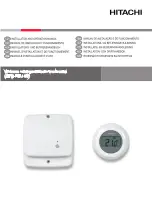
IF324_5A808_UK_M1
® Copyright CEAM Group
CEAM Control Equipment
15
8 – Operative Notes
HOW IT WORKS:
As already explained in the previous chapters, the instrument measures the temperature
through the conversion in a temperature value, of the infrared radiation taken, inside a specific frequency
gamma or wave length, which is taken by the Optical infrared Detector, which works exactly as an antenna.
This energy is directed in the centre of the optical “Focus” of the detector thanks to special transparent lens to
the radiation, in function of which it is determined the optical ratio of the instrument, that is the dimension (the
diameter) of the spot at a definite distance.
THE SIGHT FIELD:
The infrared energy taken, is directed to the centre of the optical “Focus” of the detector
thanks to special transparent lens at the radiation wave-length, the optical dimensioning of the lens
determines the optical ratio of the instrument, that is the ratio between the dimension (the diameter) of the
SPOT that you obtain at a definite distance between the instrument and the TARGET, as already largely
explained in the previous chapters , it is very important that the dimension of the SPOT must be largely smaller
then the TARGET surface to be measured, in a different case you would obtain measurement errors in function
of the thermal proportion in function of the area.
Besides on the bases of the optical Ratio it is important to remind that bigger will be the distance between the
instrument and the TARGET and bigger will be the Dimension / Diameter of the SPOT , then smaller will be the
distance and smaller will be its Dimension / Diameter as showed clearly in Pict. 1 of Chapt. 2.
Attention: The SPOT is always defined as a round area, but this is data on theory and it is true only in case the
instrument is perfectly vertical on the TARGET and with this last one perfectly flat, on the contrary if the
instrument is in a inclined position, the shape of the SPOT will be elliptical, while if we are measuring irregular
bodies, the shape of the SPOT will assume irregular shapes as consequence.
IDEA: To have an idea of how it works, it is enough to use an electric torch which produces a light cone, which
besides its dimension (Optical Ratio) if you position it in a vertical way it will produce a round lighted area,
besides if you position it in a slanting way, the shape of the lighted area will be modified, and the same will
happen making different experiments.
LASER POINTER:
to avoid any misunderstanding, we want to remind that the laser pointer, in this case,
double, does not represent the measured surface, but just a perfunctory referring point where the instrument
makes the measurement, then it must be always the operator, that on the base of the instrument optical ratio,
also printed on the side of the pyrometer, to calculate on the base of the distance, the approximate dimension
of the SPOT, to verify that it is totally contained inside the measurement TARGET.
Here below a simple but clear example where you can find both the correct using , where the TARGET
contains all the spot, and an example of incorrect using where the TARGET does not contain all the spot, in
this case the instrument will display a temperature which represents the thermal average of the read surface,
in this case not totally represented by the TARGET , then as already explained, not representative of the real
temperature of the Target.
If the TARGET would be of little dimension, and there is the risk that the spot would not be completely
covered, and as the optical is with fixed focus, it is always wise where possible to bring the instrument near to
reduce the dimension of the SPOT making then the measurement compatible and more reliable.
DIFFICULT OR IMPOSSIBLE MEASUREMENT:
just for the used technology, and not for a fault and/or shortage
of the instrument, there are measurement which cannot be made and that can even damage the instrument in
an irreparable way, let’s begin from these last ones:
Never point the instrument in front of the sun, the quantity of energy radiating and received by the instrument
is such to damage the instrument in an irreparable way.
Содержание IF324
Страница 2: ...IF324_5A808_UK_M1 Copyright CEAM Group CEAM Control Equipment 2 ...
Страница 4: ...IF324_5A808_UK_M1 Copyright CEAM Group CEAM Control Equipment 4 ...
Страница 5: ...IF324_5A808_UK_M1 Copyright CEAM Group CEAM Control Equipment 5 ...
Страница 21: ...IF324_5A808_UK_M1 Copyright CEAM Group CEAM Control Equipment 21 ...
Страница 22: ...IF324_5A808_UK_M1 Copyright CEAM Group CEAM Control Equipment 22 ...
Страница 23: ...IF324_5A808_UK_M1 Copyright CEAM Group CEAM Control Equipment 23 ...










































